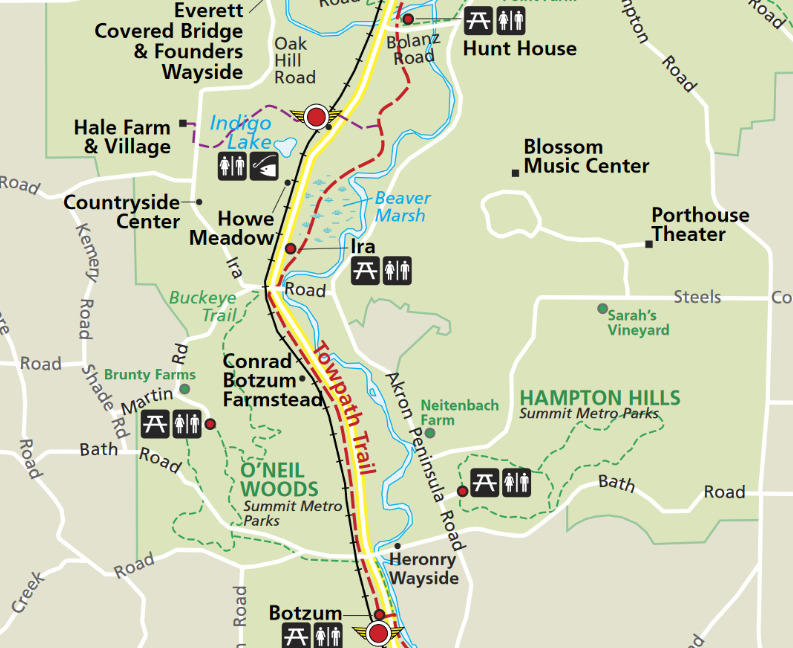Cuyahoga Valley NP--Ira Rd. Beaver Marsh

Cuyahoga Valley NP--Ira Rd. Beaver Marsh
Riverview Road Peninsula, Ohio 44264
Official WebsiteCuyahoga Valley National Park website
Cuyahoga Valley National Park map
Cuyahoga Valley National Park trail maps
Also, see all the hotspots at:
Cuyahoga Valley National Park-Lower Cuyahoga River Important Bird Area
Cuyahoga Valley National Park Birding Drive
Tips for Birding
The Ira Road Beaver Marsh is a good place to visit during the waterfowl migrations in March and November. Wetlands provide essential feeding and resting places to migrating birds. Less than 10 percent of Ohio’s original wetlands still exist, making this habitat in Cuyahoga Valley National Park especially valuable to wildlife.
A walk along the boardwalk often provides great bird watching opportunities, especially during summer, when it is possible to see birds at close range and in their peak breeding plumage. Watch for families of wood ducks in the water, look for tree swallows as they capture insects in mid-air, and listen for the single-pitched staccato trill of the swamp sparrow.
The Beaver Marsh is accessible from the Towpath Trail between the Ira and Hunt Farm Trailheads.
The Beaver Marsh is one of the best birding locations in Summit County. The trail is mixed use, so there are walkers, joggers, bicyclists, dogs, and birders using it. The section used by birders is mostly flat and roughly a mile long. There is a boardwalk that overlooks the marsh.
Birds of Interest
Virginia Rail, Sora, American Black Duck, nesting Least Bittern, Yellow- and Black-Billed Cuckoo, and many species of migrating warblers.
About this Location
The Ohio & Erie Canal Towpath Trail becomes a boardwalk over the Beaver Marsh, just north of Ira Trailhead in Cuyahoga Valley National Park. One of the best bird and wildlife viewing spots in the park, this area is a state Watchable Wildlife location and is one reason the park was designated an Important Bird Area by the Audubon Society of Ohio. The marsh exemplifies the conservation success of the park.
Once a junkyard, the area was reclaimed through beaver activity combined with clean-up efforts by park staff and volunteers.
Birdlife at the beaver pond is abundant and showy and easily accessed on the Towpath Trail and boardwalk, making it a top destination for birders in the Spring and Summer.
Along the old canal, Prothonotary Warblers, Rose-breasted Grosbeaks, and Indigo Buntings abound. Field and Song Sparrows, Common Yellowthroats, and Yellow and Blue-winged Warblers are common nesting species in the fields and meadows. Green and Great Blue Herons, Great Egrets, and sometimes, American Bitterns are joined by Virginia Rails and Soras in the healthy cattail marsh. Tree Swallows and Eastern Kingbirds put on aerial flycatching shows just overhead. During the Spring and Fall, the Beaver Pond hosts multiple species of migrating waterfowl, including American Wigeon, Northern Shoveler, Gadwall, Wood Duck, American Black Duck, and the common Mallard.
Woodpeckers are drawn to the marsh’s free-standing dead trees. Downy, Red-bellied, and Pileated Woodpeckers feed in the swamp lowlands. Overhead, Red-tailed and Broad-winged Hawks, Bald Eagle, Turkey Vulture, and sometimes Osprey will soar on warm days.
The Beaver Marsh is wildly active during Spring migration, when multiple species of warblers, vireos, thrushes, sparrows, gnatcatchers, and more work their way north along the canal and swampy river bottomland forest. During the Winter months, birders will find traveling flocks of songbirds led by chickadees, titmice, Golden-crowned Kinglet, Brown Creeper, and sparrows, including Eastern Towhee.
A host of reptiles and amphibians abound, with Eastern Garter Snake, Northern Water Snake, Black Rat Snake, Eastern Painted Turtle, Green Frog, Bullfrog, Spring Peeper, Gray Treefrog, and more. White-tailed Deer, Muskrat, Coyote, Mink, rabbit, and raccoon are common mammal residents, but the highlight is surely the active American Beaver lodge just off of the boardwalk. The health of the wetland can be attributed to last year’s sighting of a rare River Otter along the Towpath Trail.
About Cuyahoga Valley National Park
See all hotspots at Cuyahoga Valley National Park
Though a short distance from the urban areas of Cleveland and Akron, Cuyahoga Valley National Park seems worlds away. The park is a refuge for native plants and wildlife and provides routes of discovery for visitors. The winding Cuyahoga River gives way to deep forests, rolling hills, and open farmlands. Walk or ride the Towpath Trail to follow the historic route of the Ohio & Erie Canal.
Warning: All areas of the Cuyahoga Valley National Park are prone to deer ticks from the early spring until late fall, so prepare accordingly before birding.
Restrooms at locations identified on Cuyahoga Valley National Park map. Most areas have non-flush toilets; there are flush toilets available at the Pine Hollow parking lot on Quick Road and the Virginia Kendall Lake lodge building.
Notable Trails
Ira Road Beaver Marsh Towpath Trail
There are several ways to hike and visit the Ira Road Beaver Marsh.
The Ira Road trailhead is the closest to the Beaver Marsh. It is a short walk north on the Towpath Trail from this trailhead to the Beaver Marsh.
There are trailheads north and south of the Beaver Marsh. It is 3 miles from Bolantz Road on the north to Botzum on the south. Hiking out and back between them makes a 6-mile hike passing the Beaver Marsh twice. Hiking out and back from either trailhead to the Beaver Marsh is a 3-mile hike.
Another alternative, when the Cuyahoga Valley Scenic Railroad is in operation, is to walk one way to the Beaver Marsh and take the train back to your starting place. Check the railroad schedule and stops for more information on how to do this.
Features
Restrooms on site
Wheelchair accessible trail
Entrance fee
Roadside viewing
Content from Official Website, Cuyahoga Valley National Park website, Cuyahoga Valley Bird Watching at its Best brochure, Susan Carpenter, and Ohio Ornithological Society

